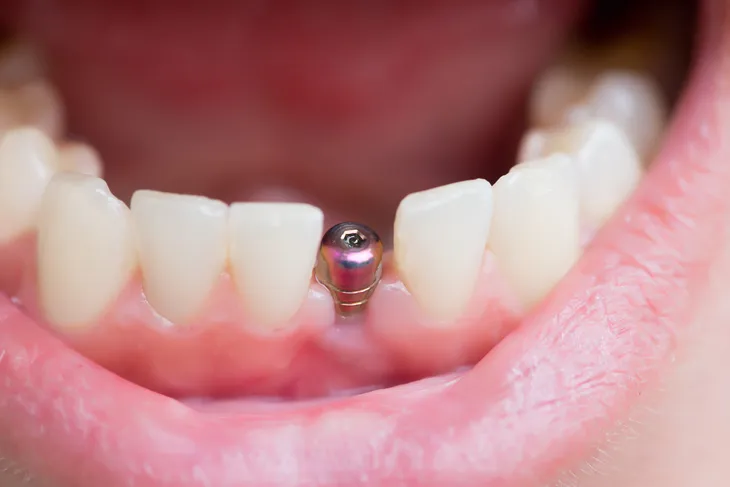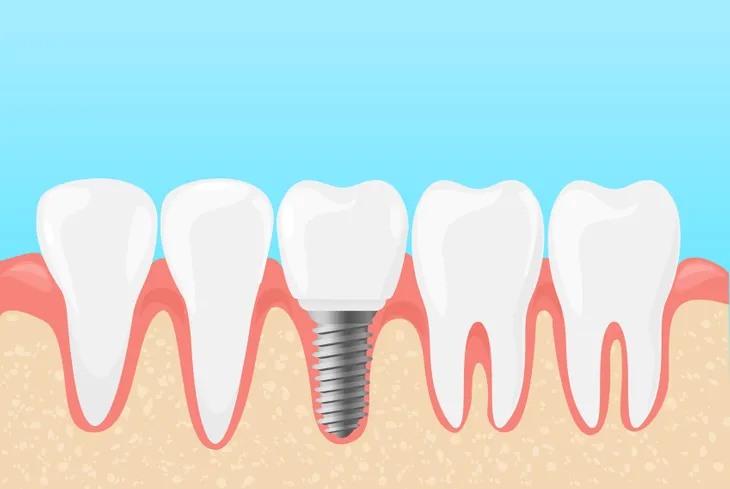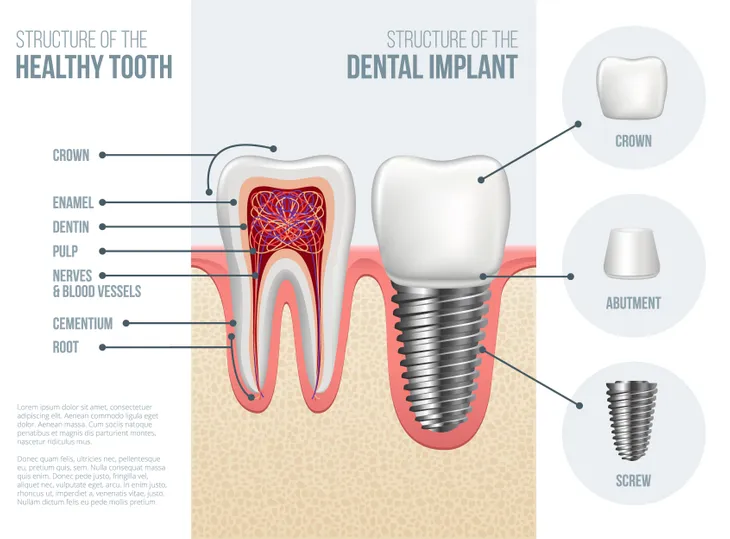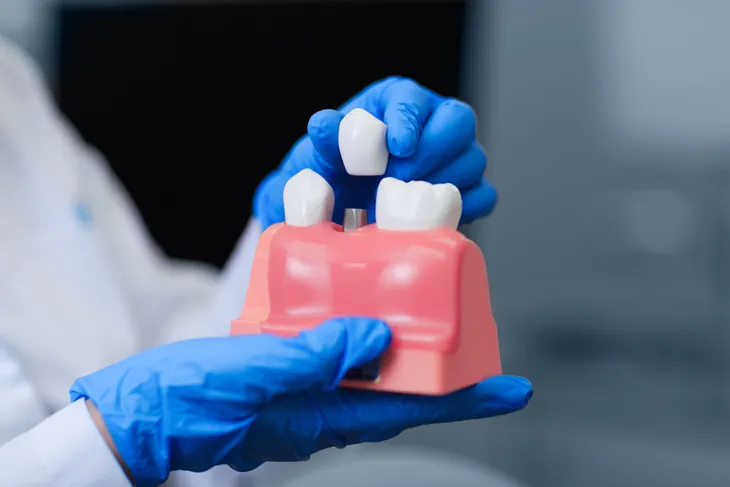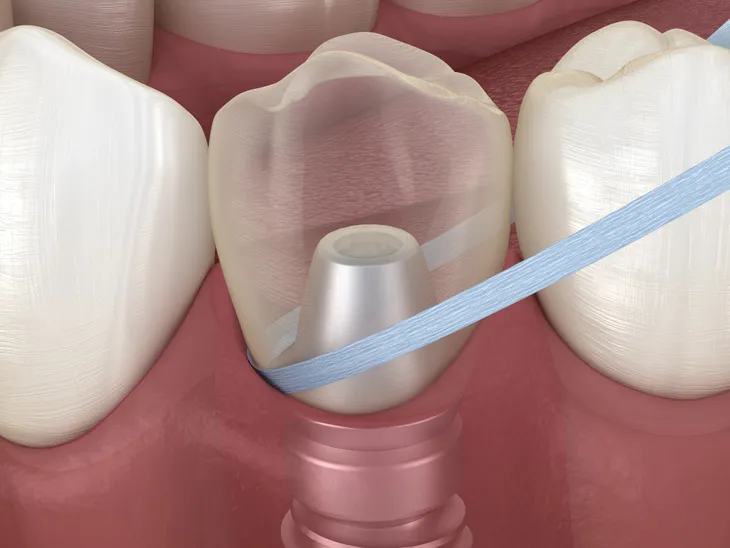Dental implant surgery is a procedure to replace damaged or missing teeth with artificial teeth. Dental implants not only look, but also function exactly like natural teeth. Many people choose dental implants over other options like dentures or bridgework because they offer a permanent and natural looking solution that lasts a lifetime!
You never have to worry about them coming loose or shifting around in your mouth because dental implants are perfectly customized to fit your mouth. You’ll finally be able to smile with confidence! Dental implant surgery is an easy and effective procedure that is also cost friendly. While the amount of procedures, exact timeline, and type of implant depends on the condition of your jawbone, overall the process is fairly straightforward. If dental implants are something you’re considering, we’ve created a detailed list on each step of the process, as well as what to expect afterwards!
1. Who Gets Dental Implants?
As we previously mentioned, dental implants are generally used for people who have missing or damaged teeth. The process of dental implant surgery requires a surgeon to surgically place the implant into the jawbone so that it is permanent and secure. In order to make sure the implant does not move around, make noise, or cause bone damage like fixed bridgework or dentures, the titanium implant must be fused into the bone. While it’s not an overly complex procedure, you do want to make sure it’s the right option for you.
The Mayo Clinic provides a list of candidates who qualify for this procedure which includes someone with one or more missing teeth, a fully grown and developed jawbone, adequate bone to secure the implant (or someone who is able to have a bone graft). They must have healthy oral tissue, no health conditions that would affect bone healing. They must be unable or unwilling to wear dentures, want to improve their speech, willing to commit to a process that may span several months, and be a non-smoker or willing to quit smoking.
Step by Step
2. Evaluation Process
There are certain qualifications that a person must meet in order to get dental implants. While the process isn’t overly complicated, it’s not for everyone and does require an evaluation process that may involve a number of experts, including one who specializes in the mouth, jaw, and face (oral and maxillofacial surgeon), a periodontist (a dentist who specializes in structures that support the teeth, such as gums and bones), as well as a dentist who can design and fit artificial teeth, says the Mayo CLinic. Not often, but sometimes it may also require a ear, nose, and throat (ENT) specialist.
The first step is to have a comprehensive dental exam. This will likely include X-rays, 3D images and models made of your teeth and jaw. They will also be evaluating the condition of your jawbone and how many teeth you’re planning on replacing.
The next step is to review your medical history. You need to inform your doctor of any medication conditions, medications (prescription and over-the-counter drugs and supplements). It’s extremely important that you inform your medical team if you have any heart conditions or orthopedic implants. If this is the case, you may need to take antibiotics ahead of the surgery to prevent infection.
Based off all the information gathered from the above steps, your dentist will sit down with you and come up with a treatment plan. This plan will be tailored to your specific needs. It will take into account how many teeth you need replaced, your medical history, as well as the condition of your jawbone and remaining teeth, adds the source.
3. Bone Grafting
Bone grafting is done if the jawbone isn’t thick enough or is too soft. Our jaw needs to be able to withstand a lot of movement and pressure. If you think about it, our jaw does a lot of work! It helps us talk, laugh, eat, yawn, and so on. Chewing is probably the biggest hurdle for our jaw because of its powerful action. If the jawbone can’t support the implant properly, the surgery will fail. This is where a bone graft comes into play. It can help create a more solid base for the implant, says the Mayo Clinic.
Since the bone graft needs to withstand immense pressure and power, what materials should we use? Well, the Mayo Clinic explains that a surgeon could replace bone with bone by taking from another location in the body. This would be a natural bone graft. There are also synthetic bone grafts made from a bone-substitute material. These are things you’ll need to discuss with your doctor.
The process for bone grafting can take a while. “It may take several months for the transplanted bone to grow enough new bone to support a dental implant,” writes the Mayo Clinic. “In some cases, you may need only minor bone grafting, which can be done at the same time as the implant surgery.” All of this depends on the condition of the jawbone.
4. Placing the Implant
The next step is to place the implant. During surgery, the oral surgeon will cut open the gums so that the bone is exposed. “Holes are drilled into the bone where the dental implant metal post will be placed,” writes the Mayo Clinic. “Since the post will serve as the tooth root, it’s implanted deep into the bone.”
Even though the implant has been placed, there will still be a gap where the tooth (or teeth) are missing. If this is an issue, the surgeon can provide a temporary denture. This is simply for appearances and can be removed for cleaning and sleeping.
5. Waiting for Bone Growth
Now that the metal implant has been placed into the jawbone, it’s time to wait for bone growth. This phase is called osseointegration (pronounced oss-ee-oh-in-tuh-GRAY-shun). “During this process, the jawbone grows into and unites with the surface of the dental implant,” explains the Mayo Clinic. “This process, which can take several months, helps provide a solid base for your new artificial tooth.” This base is similar to the roots for our natural teeth.
6. Placing the Abutment
Once osseointegration is complete, the next step is to place the abutment. The abutment is where the crown attaches. This may require an additional surgery, but don’t worry — it’s minor! According to the Mayo Clinic, this surgery is typically done under local anesthesia in an outpatient setting.
The process of placing the abutment goes as follows: first the oral surgeon will reopen the gums to expose the dental implant. The abutment is then placed on the dental implant, and then as the gum tissue heals it closes around, but not over the abutment. The healing process typically takes around two weeks before the artificial tooth can be attached, says the Mayo Clinic.
You may not require a second surgery if the abutment is attached right after the metal post is implanted. “Because the abutment juts past the gumline, however, it’s visible when you open your mouth — and it will be that way until your dentist completes the tooth prosthesis,” writes the source. Not surprisingly, some people do not like the appearance of this and would prefer to have the these two steps done separately in order to keep up appearances. The downside is that it requires an extra surgical step.
7. Choosing Artificial Teeth
Once the gums heal, you’ll need more impressions made for your mouth and remaining teeth. The Mayo Clinic explains that these impressions are used to make the crown, that beautiful realistic-looking artificial tooth. The crown will be placed once the jawbone is strong enough to hold it in place. At this point in the process, you and your dental specialist will discuss whether or not you want artificial teeth that are removable, fixed, or a combination of both.
Removable artificial teeth are similar to the conventional removable dentures and can be customized to be either fully or partially removable. “It contains artificial white teeth surrounded by pink plastic gum,” writes the source. “It’s mounted on a metal frame that’s attached to the implant abutment, and it snaps securely into place.” It is much easier to repair or clean removable artificial teeth,
A fixed artificial tooth cannot be taken out once it is placed. It is permanently screwed or cemented into the implant abutment which means it cannot be removed at night or for cleaning. “Most of the time, each crown is attached to its own dental implant,” adds the source. “However, because implants are exceptionally strong, several teeth can be replaced by one implant if they’re bridged together.”
8. After the Procedure
While dental implant surgery is a fairly straightforward procedure with a short recovery time, there can be some discomfort afterwards. Some of the most common complaints after dental implant surgery are “swelling of your gums and face, bruising of your skin and gums, pain at the implant site, [and] minor bleeding,” says the Mayo Clinic.
To cope with these symptoms, you may be prescribed some medication. The swelling and discomfort should only last a day or so, if it lasts longer or continues to get worse, contact your surgeon. The Mayo Clinic explains that you may also need to eat soft foods for a period until the discomfort subsides. Most of the time the stitches will dissolve on their own, but if they aren’t, they will need to be removed by a doctor.
Results
9. Success Rate
Dental implants have an extremely high success rate. According to the Mayo Clinic, the success rate is somewhere around 98-percent. That’s pretty good! In the rare 2-percent of cases where the procedure doesn’t work, it may be because the bone fails to fuse to the metal implant.
A large part of whether or not the procedure is a success depends on the patient. There are some steps that a patient must take after their procedure to ensure everything heals properly and their implants last a lifetime.
10. Tips on How to Improve Success
After the procedure is done, your dentist will provide specific instructions of how to keep the implants clean. Just as you do with your natural teeth, you will be required to maintain proper hygiene which means regular flossing and brushing. According to the Mayo Clinic, there are specially designed brushes for dental implants, these are called interdental brush. They slide nicely between the teeth so that all the nooks and crannies around teeth and metal posts remain clean.
You should also get in the habit of visiting the dentist on a regular basis so that they can monitor the implants and ensure they never come loose. If that does happen, don’t worry. They can usually be adjusted. Lastly, avoid engaging in any damaging habits like chewing hard items such as ice and candy. These can break the crowns or even natural teeth. You should also avoid anything that could stain your teeth, such as drinking coffee, red wine, or smoking. If you struggle with grinding your teeth, seek treatment.




